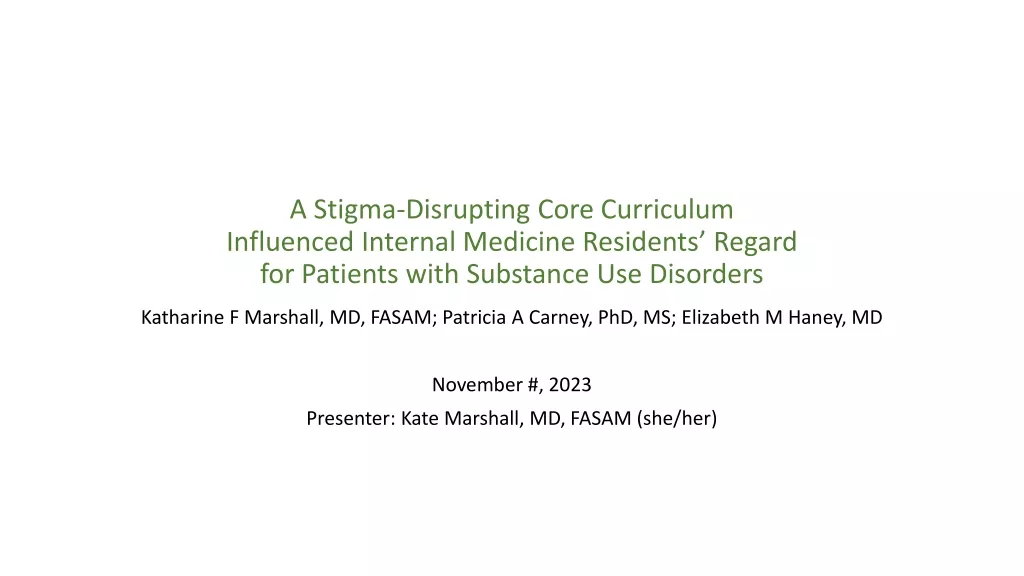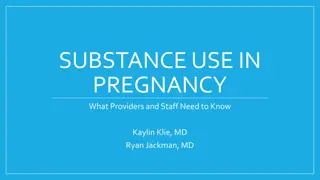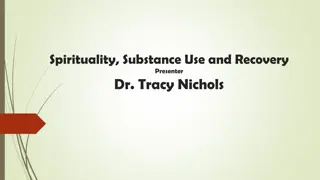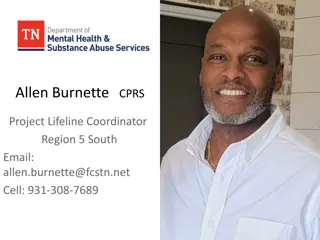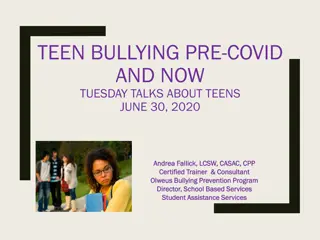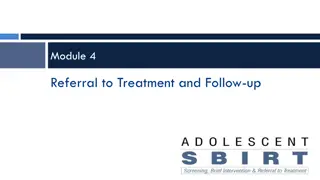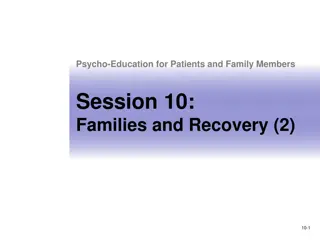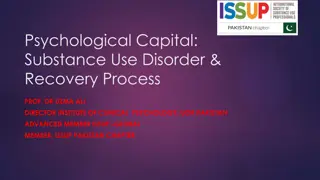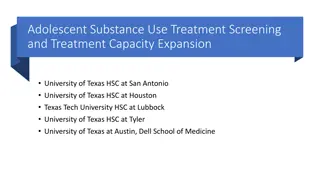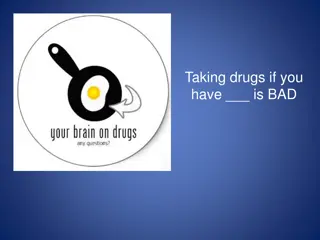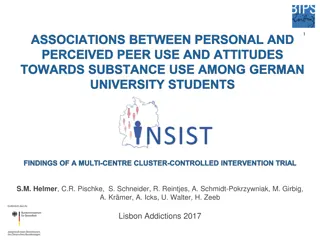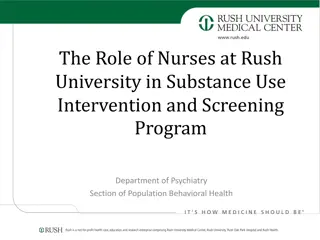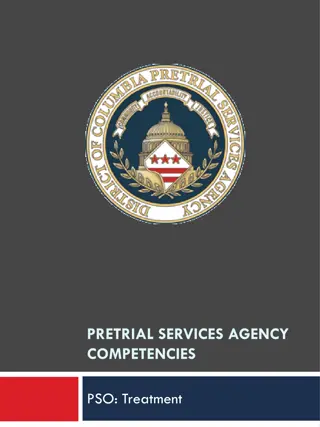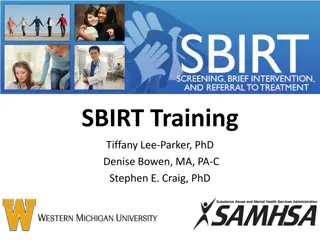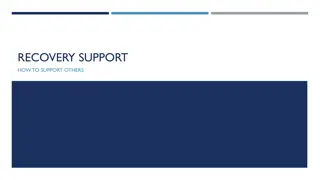Treatment and Recovery Committee Meeting for Substance Use Response Group
The Treatment and Recovery Committee, part of the Substance Use Response Group (SURG), is hosting a meeting on April 25, 2022, at 3:30 pm. The agenda includes establishing quorum, public comments, member introductions, and discussing special populations affected by substance use disorders. Join the Zoom meeting to participate in the important discussions led by Chair Assemblywoman Claire Thomas.
Download Presentation

Please find below an Image/Link to download the presentation.
The content on the website is provided AS IS for your information and personal use only. It may not be sold, licensed, or shared on other websites without obtaining consent from the author. Download presentation by click this link. If you encounter any issues during the download, it is possible that the publisher has removed the file from their server.
E N D
Presentation Transcript
TREATMENT AND RECOVERY COMMITTEE Substance Use Response Group (SURG) April 25, 2022 3:30 pm Click this Link to join the Zoom Meeting
1. CALL TO ORDER AND ROLL CALL TO ESTABLISH QUORUM Assemblywoman Claire Thomas
1. Call to Order and Roll Call to Establish Quorum Committee Role Member SURG Role Chair Assemblywoman Claire Thomas Assembly Member Appointee Member Chelsi Cheatom Harm Reduction Program Member Healthcare Provider with SUD Expertise Person in Recovery from an SUD Dr. Lesley Dickson Member Jeffrey Iverson Member Urban Human Services (Washoe County) Lisa Lee Member Steve Shell Hospital
Public Comment Public comment will be received via Zoom by raising your hand or unmuting yourself when asked for public comment. Public comment shall be limited to three (3) minutes per person (this is a period devoted to comments by the general public, if any, and discussion of those comments). No action may be taken upon a matter raised during a period devoted to comments by the general public until the matter itself has been specifically included on an agenda as an item upon which action may be taken pursuant to NRS 241.020.
3. MEMBER INTRODUCTIONS
3. Member Introductions Committee Role Chair Member SURG Role Assemblywoman Claire Thomas Chelsi Cheatom Assembly Member Appointee Harm Reduction Program Healthcare Provider with SUD Expertise Person in Recovery from an SUD Urban Human Services (Washoe County) Hospital *Non-members Member Member Dr. Lesley Dickson Member Jeffrey Iverson Member Lisa Lee Steve Shell SEI Team* Member Subcommittee Support
Committee Scope Includes consideration of special populations a. Veterans, elderly persons and youth; b. Persons who are incarcerated, persons who have committed nonviolent crimes primarily driven by a substance use disorder and other persons involved in the criminal justice or juvenile systems; c. Pregnant women and the parents of dependent children; d. Lesbian, gay, bisexual, transgender and questioning persons; e. People who inject drugs; (as revised) f. Children who are involved with the child welfare system, and g. Other populations disproportionately impacted by substance use disorders.
Committee Scope Is tasked with making progress to: (a) Leverage and expand efforts by state and local governmental entities to reduce the use of substances which are associated with substance use disorders, including, without limitation, heroin, other synthetic and non-synthetic opioids and stimulants, and identify ways to enhance those efforts through coordination and collaboration. (g) Make recommendations to entities including, without limitation, the State Board of Pharmacy, professional licensing boards that license practitioners, other than veterinarians, the State Board of Health, the Division, the Governor and the Legislature, to ensure that controlled substances are appropriately prescribed in accordance with the provisions of NRS 639.2391 to 639.23916, inclusive. (j) Study the efficacy and expand the implementation of programs to: (1) Educate youth and families about the effects of substance use and substance use disorders. With shared responsibility to: (b) Assess evidence-based strategies for preventing substance use and intervening to stop substance use, including, without limitation, the use of heroin, other synthetic and non-synthetic 4 - 81st Session (2021) opioids and stimulants. Such strategies must include, without limitation, strategies to: (1) Help persons at risk of a substance use disorder avoid developing a substance use disorder; (2) Discover potentially problematic substance use in a person and intervene before the person develops a substance use disorder; (3) Treat the medical consequences of a substance use disorder in a person and facilitate the treatment of the substance use disorder to minimize further harm; and (4) Reduce the harm caused by substance use, including, without limitation, by preventing overdoses. (c) Assess and evaluate existing pathways to treatment and recovery for persons with substance use disorders, including, without limitation, such persons who are members of special populations. (h) Examine qualitative and quantitative data to understand the risk factors that contribute to substance use and the rates of substance use and substance use disorders, focusing on special populations. (q) Study, evaluate and make recommendations to the Department of Health and Human Services concerning the use of the money described in section 10.5 of this act to address substance use disorders.
Attend meetings and communicate to the chair when unable to do so Attend Roles for Committee Members Provide recommendations in advance of meetings Provide Review materials provided in advance of meetings Review
Roles for Committee Members SURG subcommittees are expected to meet monthly and will have a chair and targeted administrative support. Groups will engage subject matter experts (SMEs) from Nevada and beyond to inform their study and recommendations. The term for the subcommittee membership is expected to be one year, beginning in March 2022 and extending to February 2023. Other important milestones are listed below: March: DHHS Needs Assessment Update; Announce Subcommittee Members and Chairs; Presentations. (completed) June: Subcommittee Progress Reports and presentations (based on monthly meetings) September: Subcommittee Recommendations Report and Discussion January: Final Report Presentation and Approval
4. REVIEW SUBCOMMITTEE RECOMMENDATION TRACKING TOOL
5. BASELINE INFORMATION FOR TREATMENT AND RECOVERY RELATED TO SUBSTANCE USE Stephanie Woodard, PsyD, Senior Advisor for Behavioral Health, Department of Health and Human Services
Overview of Substance Use Treatment, Prevention and Response Programs
Funding State General Funds help support Medicaid and infrastructure to expand prevention and treatment for justice involved, reentry and social service referrals Medicaid approved coverage of SUD services effective January 2014, offsetting the need for general fund and block grant funding for approved treatment services. All 19 provider types are able to bill and be reimbursed by Medicaid. SAMHSA Substance Abuse Block Grant SAPTA shifted block grant funding to enhance gap services including Residential, Transition Care, Targeted Case Management, Recovery-oriented Systems of Care, and Expanding Access to Recovery Support Services for Adolescents and Adults.
Certification Services SAPTA contracts with UNR CASAT to certify coalitions, as well as prevention and treatment programs SAPTA also certifies Opioid treatment programs (e.g., methadone clinics) SUD treatment programs Civil Protective Custody Drug Court Services Transitional Housing programs, and others Programs must be certified to participate in Medicaid and to receive SAPTA funding
Certified Community Behavioral Health Clinics Initial demonstrations in Fallon, Elko, Las Vegas. Targeted case management for individuals with primary substance-related disorders, chronic disease self-management and supported employment. Expanded to include MAT, ambulatory withdrawal management, primary care services, 24/7 crisis intervention (including mobile crisis), psychiatric rehabilitation services, assertive community services, and family-to-family peer interventions. There are now 16 CCBHCs, 9 of which are Medicaid enrolled providers and 7 are SAMHSA direct-funded to establish their programs.
Prevention Primary prevention includes six strategies: Information Dissemination, Education, Alternative Programs, Problem Identification and Referral, Community Based Process, and Environmental Strategies. Ten Prevention Coalitions in Nevada are guided by these strategies to Leverage qualitative and quantitative data to identify areas of focus, including SUD and suicide prevention, working with advisory groups.
Advisory Groups Multidisciplinary Prevention Advisory Committee (MPAC) advises SAPTA with a comprehensive statewide prevention strategy to share responsibility among state and local authorities. SAPTA Advisory Board (SAB) ensures availability and accessibility of treatment and prevention services within the state. Regional Behavioral Health Policy Boards (RBHPB) advise on behavioral health needs, service delivery, gaps, and allocation of funds for Clark, Northern, Rural, Southern and Washoe regions. Regional Mental Health Consortia develop long-term strategic plans and submit reports for the provision of mental health services to children in their jurisdiction.
State Opioid Response Grant Integrated opioid treatment and recovery centers (IOTRCs) created foundation for MAT SOR funds expand MAT, support outpatient clinical treatment and recovery services Tribal treatment and recovery Criminal justice treatment and recovery Peer recovery support services Community preparedness planning for tribal communities Mobile opioid recovery outreach teams Neonatal abstinence syndrome prevention
SOR Grant (Continued) Statewide distribution of naloxone kits, including overdose education. Wrap around treatment and recovery support services, including special populations Veterans, faith-based supports and increased adoption of peer-based services Expansion of criminal justice programs to support MAT re-entry program with Transitional housing, residential treatment, coordination of treatment, care coordination and job development, jail-based MAT services, and naloxone discharge programs.
Crisis Services Crisis Call Center Hubs Crisis Support Services of Nevada Mobile Crisis Teams Law Enforcement Deflection and Diversion Programs Open Beds Children s Mobile Crisis Response expanded through SAMHSA COVID 19 Emergency Behavioral Health grant Crisis Counseling Assistance and Training grant FEMA and SAMHSA funding
Specialty Services Crisis Intervention Teams (CIT) create connections between law enforcement, mental health providers and ERs. They also provide a 40-hour training for professionals who are interested in working with this population. Forensic Assessment Service Triage Teams combine staff from social services, mental health agencies and substance-related treatment agencies, within jails for behavioral health screenings, criminogenic risk/needs screenings and assessments, education groups, medical referrals, case management, and peer recovery supports. Services are provided while individuals are incarcerated and as they re-enter the community.
RECOMMENDATIONS PRESENTED TO THE INTERIM HEALTH AND HUMAN SERVICES COMMITTEE From the Joint Interim Health and Human Services Committee Meetings February 17th and March 24th 2022
Join Interim Standing Meeting HHS Recommendations February 17th Medication Assisted Treatment To expand access to MAT and recovery supports for OUD limit barriers to individuals seeking treatment regardless of the ability to pay, encourage the use of hub and spoke systems, as well as recovery support. Emphasize that the decision to initiate and maintain MAT should be made collaboratively between the individual and provider and not court systems. Establish a bridge MAT program in emergency departments. Encourage waivered prescribers to prescribe by providing incentives. Use and promote telehealth for MAT, considering the modifications that have been made under the emergency policies. Hub and Spoke Model Consider the parity in coverage and participation in a statewide hub-and-spoke model across all payers with limitations on fail-first treatment options, prior authorization, and coverage limits. Service Delivery Design Engage individuals with lived experience in programming design considerations. Implement follow ups and referrals to support and care; linkage of care for incarcerated, court involved individuals and pregnant women with OUD.
Join Interim Standing Meeting HHS Recommendations March 24th Workforce More mental health professionals and SUD professionals to work side by side with us in our schools. We need to enable our educators to build their own capacity to address psychological first aid of students Provide educational opportunities to increase competency of clinicians providing adolescent care Provide educational opportunities to increase programmatic implementation of evidence-based services is critical to develop person centered care for adolescents Investment of behavioral health workforce, mitigating the stress & burnout covid-19 has caused . Use and promote telehealth for MAT, considering the modifications that have been made under the emergency policies. Surgeon General Recommendation: Expand and support the mental health workforce. DHHS Policy Recommendation: Consider radical changes to recruitment retention, and compensation of state frontline health care workers.
Join Interim Standing Meeting HHS Recommendations March 24thCont d Service Delivery Design Co-located integrated supports in school settings. Employ safety checks within our mobile crisis teams through technology. The children s mobile crisis needs to have increased use, explore co-response models to have true para response professionals, and we need to increase the robustness of caseworker training. Intensive in-home services, peer-operated respite care, short term residential facilities. Right now, there is no crisis stabilization unit for adolescents in the state of Nevada. We are short acute psychiatric beds for northern and rural NV specifically, intermediate care facilities, and psychiatric residential treatment facilities. More specialized services; our services and service delivery systems are aimed specifically to include all youth and youth with disabilities. There are few beds in the state that will take youth with developmental disabilities, we have to figure out how to make appropriate 24- hour placements. More intensive in-home services, foster care, intensive service coordination Residential interventions Have a group of oversight with people who know the best practices in residential interventions We must have connections to communities, families, and aftercare when they are still in a residential intervention
Join Interim Standing Meeting HHS Recommendations March 24thCont d Service Delivery Design Significantly increased capacity is needed for intensive care coordination to facilitate transitions and to divert youth a risk of higher level of care and/or system involvement Surgeon General Recommendation: Support the mental health needs of youth involved in the juvenile justice system. Surgeon General Recommendation: Support the mental health needs of youth in the child welfare system. DHHS Policy Recommendation: Fully support alternative funding and service delivery models for intensive care coordination. DHHS Policy Recommendation: Expand clinical quality oversight of residential care systems, and fully support any necessary remediation or expansion efforts at facilities. To get ahead of the curve or to anticipate needs, we should be working on implementing a state plan/infrastructure for pediatric disaster behavioral health response and recovery as well as general hospital consultation-liaison services. We need to put more effort in youth substance use disorder services. Increase timely data collection and research to identify and respond to youth mental health needs more rapidly--All of these are sourced from a perspective of community resiliency-based solutions
Join Interim Standing Meeting HHS Recommendations March 24thCont d Funding Including federal funding for access to services School based mental health Telehealth Integration behavioral health in pediatrics primary care Strengthen efforts to decrease youth suicide risk Addressing workforce challenges and shortages and consider incentives and loan forgiveness for behavioral health workforce Consider ways to get all payers in the system to reimburse for crisis services Invest in and expand University masters level clinicians programs
Join Interim Standing Meeting HHS Recommendations March 24thCont d Data Including federal funding for access to services School based mental health Telehealth Integration behavioral health in pediatrics primary care Strengthen efforts to decrease youth suicide risk Addressing workforce challenges and shortages Consider ways to get all payers in the system to reimburse for crisis services invest in and expand University masters level clinicians programs
6. CONSIDER RECOMMENDATIONS FOR PRESENTATIONS FROM SUBJECT MATTER EXPERTS FOR FUTURE MEETINGS Dr. Terry Kerns
7. MAY MEETING DATE May 16, 2022, 8:30 a.m.
Public Comment Public comment will be received in-person via the Zoom Meeting. Public comment shall be limited to three (3) minutes per person (this is a period devoted to comments by the general public, if any, and discussion of those comments). No action may be taken upon a matter raised during a period devoted to comments by the general public until the matter itself has been specifically included on an agenda as an item upon which action may be taken pursuant to NRS 241.020.
ADDITIONAL INFORMATION, RESOURCES & UPDATES AVAILABLE AT: https://ag.nv.gov/About/Administration/Substance _Use_Response_Working_Group_(SURG)/


